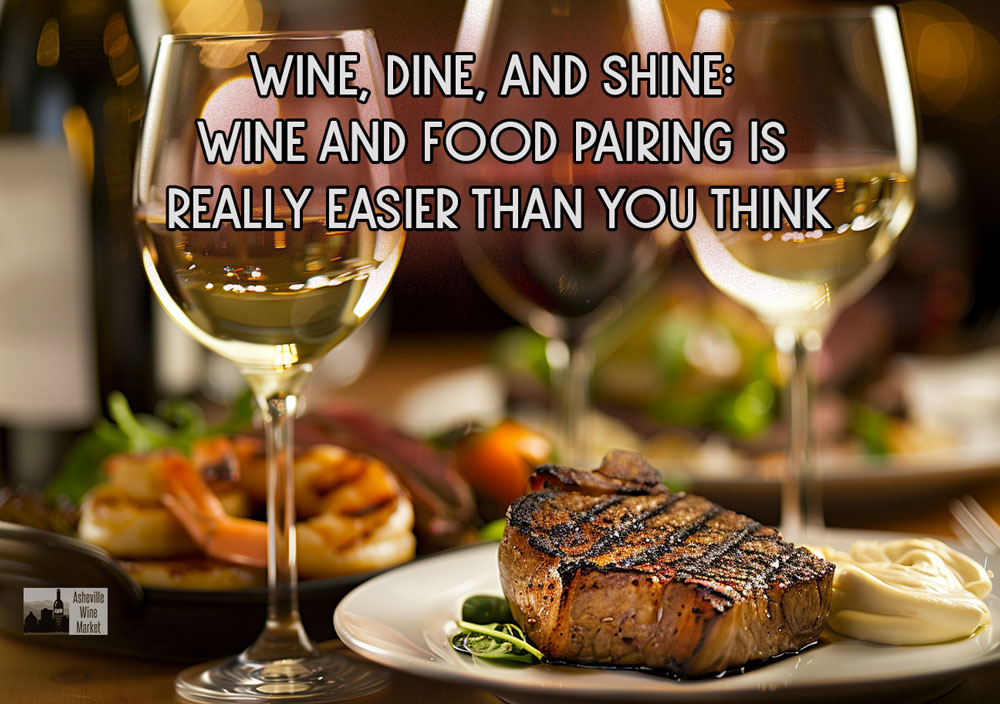
We kicked off our 2025 AWM wine dinners last week with a fantastic evening featuring food crafted by our friend and neighbor, Adam Thome, Chef and owner of 67 Biltmore. Adam’s culinary creations paired so effortlessly with the wines that many folks asked how we arrived at these flawless pairings. Today, we’re pulling back the curtain on our approach and sharing some general ideas to help you embark on your own wine and food pairing adventures.
Plenty of general guidelines are floating around when it comes to pairing wine and food; however, there’s really just one hard and fast rule: if you like it, then it’s a perfect pairing. In an age where information is everywhere and opinions are louder than ever, filter out the noise and trust your own palate and judgment. You’ll be amazed at how well you can create your own perfect pairings!
A great starting point for pairing is to consider where wine is produced and what foods are native to that region — seriously, this may be the one ultimate cheat sheet for pairings. Local populations have spent centuries fine-tuning which wines work best with their traditional dishes, and most often, they’re the ones produced locally. Think of the classic match of Sangiovese and pasta with red sauce or the perfect pairing of regional rosés with world-class hams from parts of Italy, France, and Spain. It’s no accident that coastal areas lean towards light, mineral-driven whites to go with their freshly caught shellfish — think Picpoul and Muscadet.
Another useful concept in the pairing toolbox is whether you want the wine to complement the dish or contribute a contrasting counterpoint. A buttery-rich Chardonnay can resonate with the richness of a buttery lobster preparation. You’ll arrive at an equally enjoyable, albeit significantly different, pairing with a crisp, mineral-driven white like Jacquere from the Savoie. The Jacquere offers a refreshing contrast that cleanses your palate between buttery bites.
If sauce plays a prominent role on the plate, it may lead your pairing consideration away from the principal ingredient. A dish like Chicken Cacciatore, with its rich tomato sauce, mushrooms, and bell peppers, will shine when paired with a medium-bodied Sangiovese or a soft-tannin Merlot. On the other hand, chicken prepared in a cream-based Alfredo sauce will pair nicely with a rich Chardonnay or full-bodied white Rhône.
When pairing reds with spicy foods, it’s always best to choose wines that are super-soft in the tannin department. Firm tannins can clash with the heat of spicy dishes like chili, Cajun, or Tex-Mex, resulting in an angular and sometimes bitter edge. You can even choose a rich, full-bodied red if the tannins are gentle, allowing the heat to blend harmoniously.
Matching the weight and intensity of the wine to the food can also be key. This can seem straightforward with obvious pairings like fish and steak; however, it can get more nuanced with soups, stews, and sauces. A great example is the Coq au Vin Adam prepared for our Wine Dinner last week—one we’ll revisit on our second night this Wednesday. His lighter riff on this classic French bistro dish paired perfectly with the bright, refreshingly lifted Gamay from Château Montdomaine, striking a beautiful balance between the food and the wine.
Without question, food and wine pairing is a highly personal journey —there are no strict rules, and what counts is what works for you. Take dark chocolate and big, bold reds as an example. While some adore pairing their cherished Napa Cabs with dark chocolate, others (myself included) might prefer to enjoy dark chocolate alongside a glass of Madeira or Tawny Port. It all comes down to your personal taste.
To wrap up, here’s a short list of some of Hammond’s and my favorite pairings:
Pinot Noir: Roasted chicken, mushroom-centric dishes, grilled salmon, and tuna
Cabs, Merlot, Bordeaux, etc.: Grilled or seared red meats, rich stews and ragouts, and lamb chops
Grenache and Syrah from the Rhône: Lamb shanks and lamb chops
Rosé: Anything pink—from ham and tuna to salmon– or saffron-infused dishes like Bouillabaisse and Paella, plus our absolute favorite, the Low-Country classic of Shrimp and Grits
Chardonnay: Perfect with chicken or shrimp salads and rich white-fleshed fish preparations
Crisp, fresh whites like Sauvignon Blanc, Picpoul, and Muscadet: Our go-to for shellfish dishes of all kinds
I hope these insights inspire your next culinary and vinous adventure. Remember, the perfect pairing is the one that brings you joy—so trust your palate and keep an eye out for more AWM Wine Pairing Dinners.
